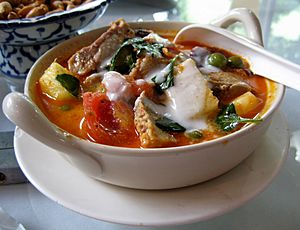Fusion cuisine facts for kids


Fusion cuisine is a type of cooking that mixes ideas and ingredients from different food traditions. These traditions often come from different countries, regions, or cultures. Think of it like mixing your favorite flavors from different parts of the world to create something new and exciting!
Sometimes, fusion food happens naturally over time as cultures interact. Other times, it's created by chefs who want to invent new and interesting dishes, especially since the 1970s.
Contents
What is Fusion Cuisine?
Fusion cuisine is all about combining different cooking styles. It's a broad term that covers many ways of mixing food traditions. While chefs often create new fusion dishes, this mixing can also happen naturally within a region's food culture.
Where Does Fusion Food Come From?
Fusion food can be found in large areas like East Asia or European cuisine. It also appears in specific and well-known ethnic cuisines such as Chinese, Japanese cuisine, Korean cuisine, French cuisine, and Italian cuisine.
For example, some restaurants focus on "Asian fusion." They combine dishes from different Asian countries like East Asia, Southeast Asia, and South Asia. They might offer traditional dishes from these places, or create new dishes inspired by mixing them.
California cuisine is another type of fusion. It takes ideas from Italy, France, Mexico, and East Asia. Then, it uses these ideas to make traditional dishes with new ingredients. A great example is California pizza.
Examples of Fusion Dishes
- In the United Kingdom, fish and chips can be seen as an early fusion dish. It combines ideas from Jewish, French, and Belgian cooking.
- Filipino cuisine is often called the "original Asian fusion cuisine." It blends local cooking traditions with influences from Spain, Latin America, China, and the United States. This happened because of the unique history of the Philippines.
- In Australia, fusion food is becoming very common. Many cafes and restaurants now mix different food styles, especially Asian-fusion.
- Foods in Malaysia and Indonesia are also great examples of fusion. They mix Malay, Javanese, Chinese, and Indian flavors. They also have small influences from Thai, Portuguese, Dutch, and British cuisines.
Creative Combinations
Sometimes, fusion cuisine means taking a dish from one culture and making it with ingredients from another.
- Think of "Taco Pizza." This dish mixes Italian and Mexican foods. It's a pizza made with cheddar and pepper jack cheese, salsa, and refried beans.
- Another example is fusion-sushi. You might find maki rolls made with different types of rice and ingredients like curry or basmati rice. Or even cheese and salsa with Spanish rice!
- Some fusion cuisines become so popular that they are accepted as a national cuisine. An example is Peruvian Nikkei cuisine. This combines Japanese spices and seasonings with Peruvian ingredients like ají (Peruvian peppers) and seafood. A famous Peruvian Nikkei dish is 'Maki Acevichado,' which is like a ceviche roll.
Who Started Fusion Cuisine?

Many people believe that Wolfgang Puck was one of the first chefs to make fusion cuisine popular. His restaurant Chinois on Main was named after a term used by Richard Wing in the 1960s. Wing combined French and Chinese cooking at his restaurant in California.
Chef Norman Van Aken was the first person to actually use the phrase "fusion cooking." He said it during a speech in Santa Fe in 1988. Soon after, a journalist wrote about his work, and the term spread all over the world!
See also
 In Spanish: Cocina fusión para niños
In Spanish: Cocina fusión para niños


